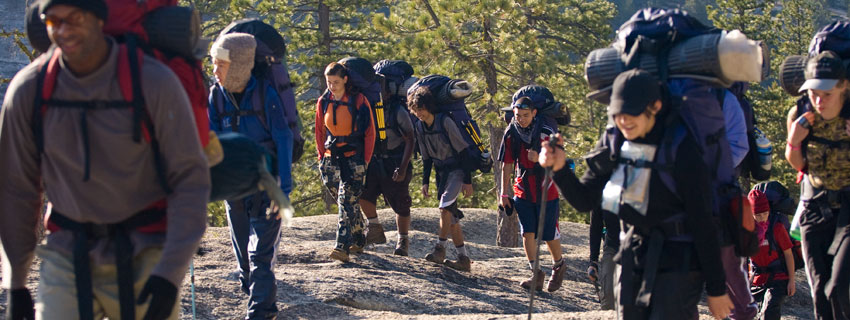Why Are There Group Size Limits?
Most wilderness areas in the Sierra Nevada have a limit on the number of people allowed in overnight backcountry groups. Although the size limits vary, most areas allow groups of no more than 15 people to camp and travel together. So… why the limit?
GROUPS HAVE A LARGER IMPACT ON THE WILDERNESS AND WILDLIFE
Trail Impacts: Hiking in larger groups compounds our footprints. One person crossing a meadow might not do much, but a dozen people in a line will establish a trail.
Campsite Impacts: When we camp in large groups, we risk trampling the soil/plants. We may end up creating a trail to reach the river from camp, building a larger fire, or going to the bathroom in one general area.
Scaring Wildlife: Larger groups make more noise and are likely to scare off wildlife. This disturbs the natural habits of animals and (from a selfish perspective) means we won’t get to see these animals in their natural setting.
GROUPS HAVE A LARGER IMPACT ON OTHER VISITORS
We go into wilderness partly to escape the intrusions of other people. Crossing paths with a large group of noisy hikers can detract from the wilderness we came to enjoy.
According to the Wilderness Act, a designated wilderness area must pose “outstanding opportunities for solitude.”
For more ideas about minimizing your impact on other visitors, check out what Leave No Trace has to say on the subject.
OFF-TRAIL TRAVEL
Many wilderness areas make a distinction between travel “on trail” and traveling “off trail” or “cross country.” When we leave an established trail, we’re entering a more pristine and wild place, and our habits need to change. We’re likely leaving the trail to find a more solitary place and to avoid seeing other people. For this reason many wildernesses in the Sierra Nevada place a limit of eight people or less on groups traveling off trail. For more on traveling cross country, see what Leave No Trace has to say about traveling on durable surfaces.
SOLUTIONS FOR LARGE GROUPS?
Can we hike as two groups and then camp together at night? How about hiking as one group and camping a mile apart? The point of group size limits is to avoid the impacts of large groups, both on the trail and in camp. As with other wilderness regulations, weaseling around the rule ends up hurting the wilderness place we came to enjoy. So what’s the solution for those thirty girl scouts or twenty five student school groups?
- Plan ahead and prepare: Learn the size limits for the area you’d like to visit ahead of time and avoid the problem.
- If you have a group that’s too large, take two separate trips from different trailheads. Smaller groups provide for a better trip all-around.
- Change your trip destination to a non-wilderness area that allows larger groups.
Of course, we need to have fun and enjoy ourselves in wild places. That’s partly what wilderness is all about: freedom. As always, however, we need to do so in a way that doesn’t damage the place we came to enjoy or hamper others’ ability to do the same.
